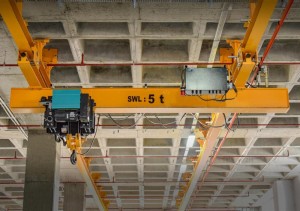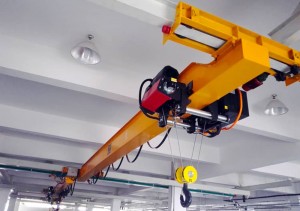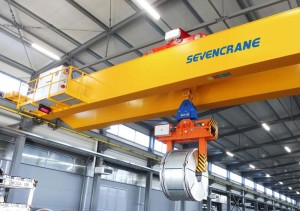
Warehouse Specialized Single Girder Overhead Crane with Electric Hoist
Product Details
♦End Beam: The end beam connects the main girder to the runway, allowing smooth crane traveling. It is precisely machined to ensure accurate alignment and stable movement. Two types are available: the standard end beam and the European type, which features compact design, low noise, and smoother running performance.
♦Cable System: The power supply cable is suspended on a flexible coil holder for the hoist’s movement. Standard flat cables are provided for reliable power transmission. For special working conditions, explosion-proof cable systems are available to ensure safety in hazardous environments.
♦Girder Section: The main girder can be divided into two or more sections for easier transportation and on-site assembly. Each section is manufactured with precision flanges and bolt holes to guarantee seamless connection and high structural strength after installation.
♦Electric Hoist: Mounted on the main girder, the hoist performs the lifting operation. Depending on the application, options include CD/MD wire rope hoists or low headroom electric hoists, ensuring efficient and smooth lifting performance.
♦Main Girder: The main girder, linked with end beams, supports hoist traversing. It can be fabricated in standard box type or European lightweight design, meeting different load and space requirements.
♦Electrical Equipment: The electrical system ensures safe, efficient operation of the single girder bridge crane and hoist. High-quality components from Schneider, Yaskawa, and other trusted brands are used for reliability and long service life.
Technical Features
Single girder overhead cranes are designed with multiple protection systems to ensure safe, stable, and reliable operation in various working environments. Key features include:
Overload Protection: The overhead crane is equipped with an overload protection limit switch to prevent lifting beyond the rated capacity, ensuring the safety of both the operator and equipment.
Lifting Height Limit Switch: This device automatically stops the hoist when the hook reaches the upper or lower limit, preventing damage caused by over-travel.
Anti-Collision PU Buffers: For long-travel operations, polyurethane buffers are installed to absorb impact and prevent collisions between cranes on the same runway.
Power Failure Protection: The system includes low-voltage and power-failure protection to avoid sudden restarts or equipment malfunction during power interruptions.
High-Protection Motors: The hoist motor is designed with protection grade IP44 and insulation class F, ensuring durability and stability under continuous operation.
Explosion-Proof Design (Optional): For hazardous environments, explosion-proof hoists can be provided with EX dII BT4/CT4 protection grade.
Metallurgical Type (Optional): Special motors with insulation class H, high-temperature cables, and thermal barriers are used for high-heat environments such as foundries or steel plants.
These comprehensive safety and protection features ensure long-term, reliable, and secure crane operation under diverse working conditions.




Production Process
A standard single girder overhead crane is usually completed within 20 days through the following precise manufacturing steps:
1. Design & Production Drawings: Professional engineers create detailed design drawings and conduct structural analysis. The production plan, material list, and technical requirements are finalized to ensure accuracy before fabrication.
2. Steel Plate Unrolling & Cutting: High-quality steel plates are unrolled, leveled, and cut into specific sizes using CNC plasma or laser cutting machines to guarantee precision and consistency.
3. Main Beam Welding: The web plate and flanges are assembled and welded under strict quality control. Advanced welding techniques ensure high strength, rigidity, and perfect beam alignment.
4. End Beam Processing: End beams and wheel assemblies are precisely machined and drilled to ensure smooth connection and accurate running on the runway beam.
5. Pre-Assembly: All main parts are trial-assembled to check dimensions, alignment, and operation accuracy, ensuring flawless installation later.
6. Hoist Production: The hoist unit, including motor, gearbox, drum, and rope, is assembled and tested to meet the required lifting performance.
7. Electrical Control Unit: Control cabinets, cables, and operating devices are wired and configured for safe and stable electrical operation.
8. Final Inspection & Delivery: The crane undergoes full load testing, surface treatment, and quality inspection before being carefully packaged for delivery to the customer.
















